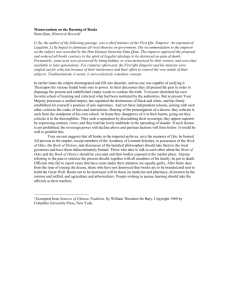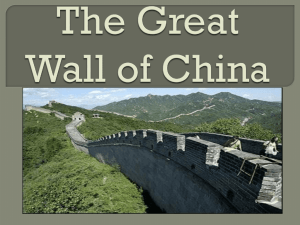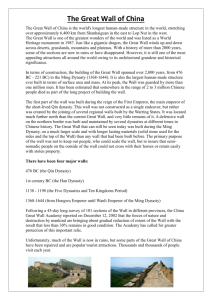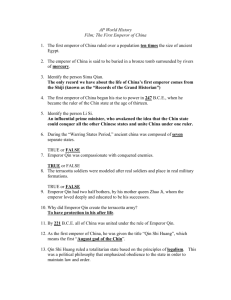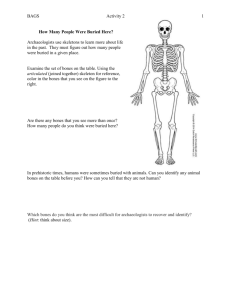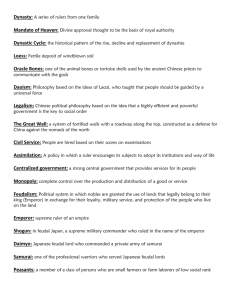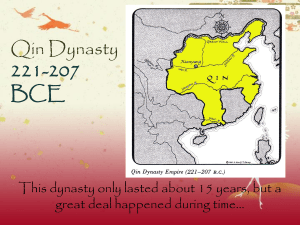The Great Wall
advertisement
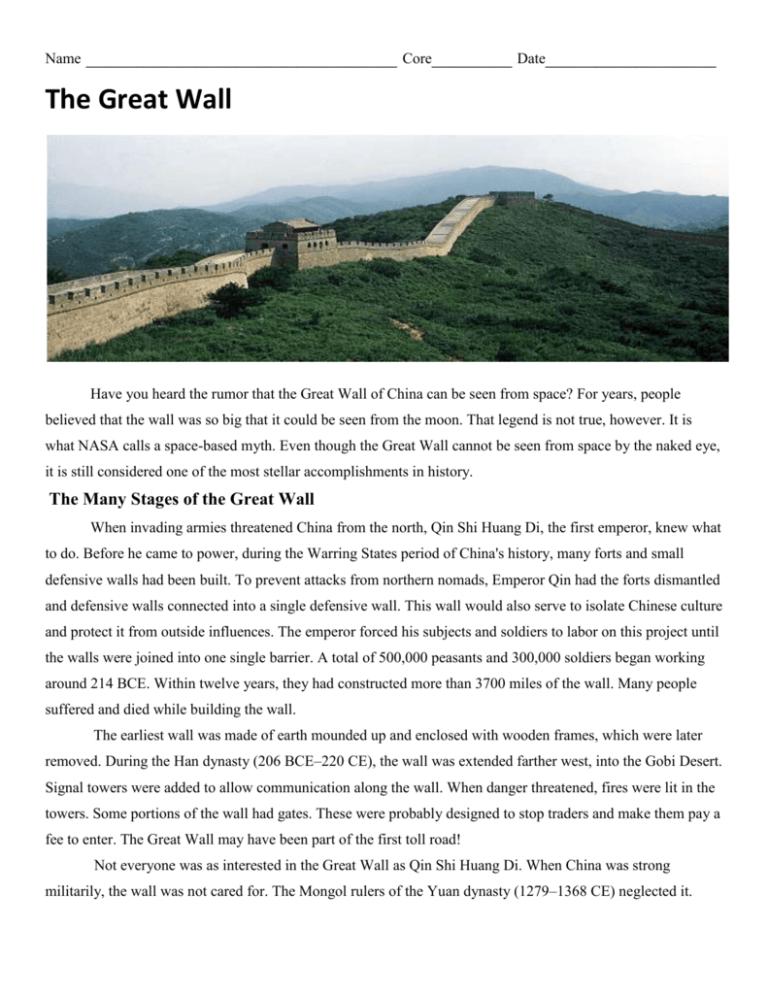
Name _______________________________ Core________ Date_________________ The Great Wall Have you heard the rumor that the Great Wall of China can be seen from space? For years, people believed that the wall was so big that it could be seen from the moon. That legend is not true, however. It is what NASA calls a space-based myth. Even though the Great Wall cannot be seen from space by the naked eye, it is still considered one of the most stellar accomplishments in history. The Many Stages of the Great Wall When invading armies threatened China from the north, Qin Shi Huang Di, the first emperor, knew what to do. Before he came to power, during the Warring States period of China's history, many forts and small defensive walls had been built. To prevent attacks from northern nomads, Emperor Qin had the forts dismantled and defensive walls connected into a single defensive wall. This wall would also serve to isolate Chinese culture and protect it from outside influences. The emperor forced his subjects and soldiers to labor on this project until the walls were joined into one single barrier. A total of 500,000 peasants and 300,000 soldiers began working around 214 BCE. Within twelve years, they had constructed more than 3700 miles of the wall. Many people suffered and died while building the wall. The earliest wall was made of earth mounded up and enclosed with wooden frames, which were later removed. During the Han dynasty (206 BCE–220 CE), the wall was extended farther west, into the Gobi Desert. Signal towers were added to allow communication along the wall. When danger threatened, fires were lit in the towers. Some portions of the wall had gates. These were probably designed to stop traders and make them pay a fee to enter. The Great Wall may have been part of the first toll road! Not everyone was as interested in the Great Wall as Qin Shi Huang Di. When China was strong militarily, the wall was not cared for. The Mongol rulers of the Yuan dynasty (1279–1368 CE) neglected it. This is probably not surprising, as they were from Mongolia on the other side of the wall! Over time, erosion also destroyed sections of the wall. The wall in its present form was built mainly by Ming dynasty rulers (1368–1644 CE), who succeeded the Mongol rulers. They built a new wall to ensure that invaders from the north would not seize control of the government again. It was parallel to the old one, but farther south. This 5,500-mile wall was made of stone and baked brick and was, therefore, more solid. The Great Wall was more than just a wall. On the top were temples, teahouses, and barracks for the soldiers guarding the wall. When the Ming fell from power, however, the wall was again neglected. Today, portions of it have been rebuilt. It remains the longest structure ever made. The wall in most places is about 25 feet high and that same distance wide. It is not, however, an unbroken wall. In some places, the land formed a barrier that made a wall unnecessary. A Legend Many legends and stories about the Great Wall exist. One well-known story has been passed down through centuries, with different details added over time. All of the versions of this story focus on a heroine, Meng Jiangnu. A temple to her has been built near the eastern end of the Great Wall. In the days of the first emperor, Qin Shi Huang Di, a wax-gourd plant in an old bachelor’s garden grew over the wall and onto a neighbor’s rooftop. When the gourd was ripe, it fell, revealing a baby girl. She grew into a beautiful young woman who was talented in music, painting, chess, and calligraphy. The Great Wall was being built, but as soon as one section was complete, another fell down. An official suggested that one man should be buried every few feet in the wall to make it stronger. Instead of burying 10,000 men, though, the official said the young scholar Fan Xiliang was worth that many men, and he should die. When Fan heard of the plot, he escaped. He arrived several days later at a garden with a half-open gate. He crept through the open gate to find a safe place to sleep. In the morning, when Meng Jiangnu went out to the garden, she discovered him. On hearing Fan’s story, Meng Jiangnu’s father was determined to have him as a son-in-law. But just as the marriage ceremony was concluding, officials from the emperor arrived. They bound Fan and dragged him away, leaving Meng Jiangnu weeping. Three years went by with no word, and Meng Jiangnu decided to seek her husband. He had told her there was no hope, but she took a winter coat for him and headed toward the Great Wall. After many adventures, Meng Jiangnu arrived at the wall. She wept so hard that part of the wall collapsed. She dreamed that Fan told her she could find his bones by testing the bones with a drop of her blood. If the bones absorbed the blood, they were his. When she found her husband’s bones this way, she gathered them to take them home. A leader seized her for damaging the wall and took her to the Qin emperor himself. Enchanted by her beauty, the emperor wanted her for his wife. Meng Jiangnu refused. She leaped from the wall into the sea instead of marrying the emperor. Today, people wonder if this legend suggests that there may actually be bodies buried in the Great Wall. We do know that thousands of workers died in the construction of the wall. Historians, however, now believe that workers were not buried within the wall but instead buried in trenches alongside the wall. If bodies had been buried within the wall, this would have weakened the wall’s structure and ultimately caused it to collapse. The Wall Restored When the Communists gained control of China in 1949, their leader, Mao Zedong, used the Great Wall as a symbol of the country. It had been built by ordinary people, who would also build a new China. The wall became a tourist destination and a site that Chinese children went to visit. In 1972, U.S. President Richard Nixon visited China for a week. This trip was significant because no American officials had visited China since the Communist takeover in 1949. On the plane trip to China, President Nixon practiced using chopsticks to eat meals. He and his wife were eager to tour the country when he was not in meetings. They went to the Great Wall near Beijing, the capital. Since Nixon’s visit, every U.S. president except Jimmy Carter has visited China. Since 1987, the Great Wall has been a World Heritage Site. UNESCO, the United Nations Educational, Scientific, and Cultural Organization, works with the people of China to preserve this historic structure. Images of the Great Wall are now used on postage stamps and in advertising. Featured at the 2008 Olympics, held in Beijing, the wall is a symbol of China. In fact, it is so much a part of Chinese identity that China’s first space rocket was launched by a company named for the Great Wall. The Great Wall of China may not be visible from space, but it certainly makes a tremendous impact here on Earth. __________________________________________________________________________________________ Question (8 points) 1. China’s Great Wall has become an important symbol of Chinese culture and history. In what ways has its importance been demonstrated throughout history? Provide evidence from the passage to support your answer.



